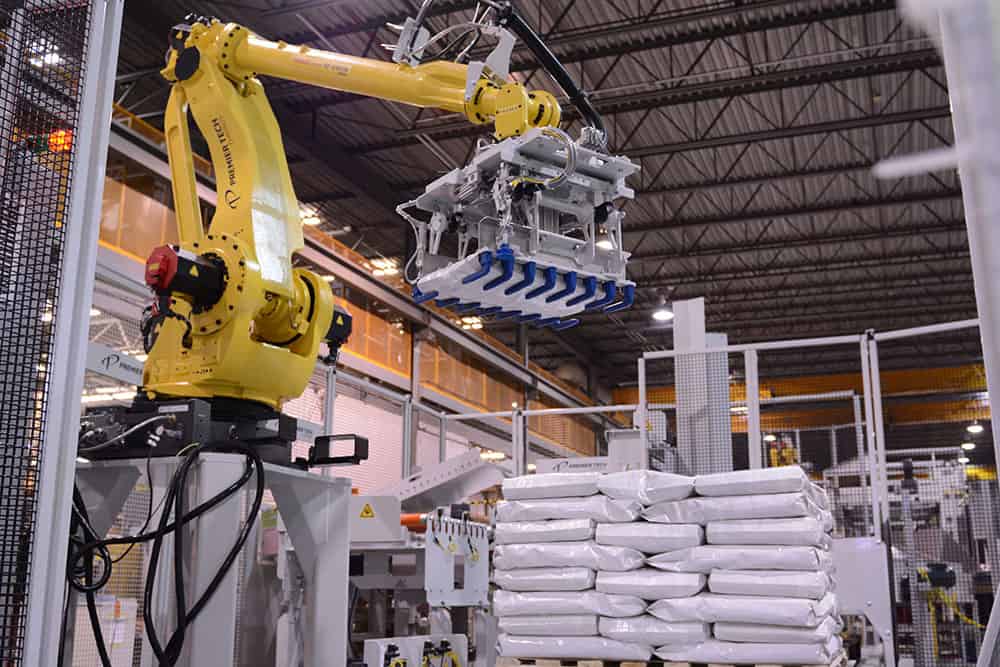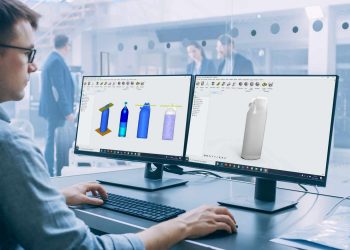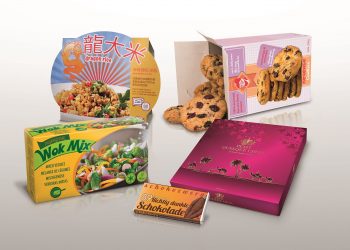Even though robotic palletizers look like machines from a science fiction movie, they’ve been around for 20 years and are now commonplace in warehouses around the world. These large robotic arms have allowed for revolutionary improvements in terms of speed and efficiency, but also in the safety of workers.
While the machine itself has essentially been the same since its invention, the biggest improvement to robotic palletizers over the years has come from the sensors and algorithms used to detect the types of loads being handled. This took robotic palletizers from a solution simply used to carry heavy loads that humans couldn’t handle to a method that was downright more efficient than using workers to do the job.
The Advantages of Robotic Palletizing
Robotic palletizers have revolutionized the manufacturing sector for several reasons, but a few of them were unexpected:
Reduced size
While most robotic palletizing solutions still require conveyor belts to carry products, the machines themselves undeniably have a smaller footprint than conventional palletizers. Additionally, since they’re more efficient, you’re getting more production out every square foot.
Versatility
These machines can be used for a variety of uses and types of loads. Not only can you change the end of arm tooling on certain models, but all robotic palletizers can be used for a completely different type of pallet simply by modifying its software.
Worker safety
The initial push for the invention of these machines has always been to improve worker safety. The repetitive movements now executed by robotic palletizers have proven time and time again to be extremely detrimental to the human body. This means this is an investment that pays itself off in several different ways.
Better handling
Warehouses can be chaotic environments, lack of space to operate machinery and tired workers can easily lead to a torn bag or dropped case. Robotic palletizers are perfectly calibrated to handle the size of your loads and lead to a dramatic decrease in broken or lost product.
An Overview and Explanation of End of Arm Tooling
End-of-Arm Tooling (usually referred to as EOAT or EOA tooling) refers to the material handling application on a piece of industrial equipment. The EOAT manipulates the product by using different techniques to hold it, depending on the product’s characteristics.
This is what makes robotic palletizers so efficient since it allows them to handle a variety of different applications. Does your production line handle different types of bags? Do you need to carry different consistencies of product such as flour and grain? Do you have multiple recipes per line? All these issues can be fixed by selecting the correct end of arm tooling.
Best Use Cases for Robotic Palletizing
As mentioned, one of the huge benefits of robotic palletizing is that it can be made to fit almost any manufacturing floor better and more efficient. However, the place where they shine the most is in situations where fragile products with high margins of error are involved.
Handling pallets of bottle cases for example is notoriously difficult because the bottles can move around in their case and easily break if they are mishandled. Since robotic palletizers are perfectly calibrated to the size of your cases, broken bottles become a lot less likely.
Bags of flour or pet food made out of paper aren’t the most resistant and often end up torn, spilling product everywhere if they aren’t handled properly. Robotic palletizers absolutely shine with bags, as they can be equipped with a vacuum gripper, a tool that makes it much more unlikely for a bag to get damaged in transport.
Robotic palletizers are no longer a futuristic tool or even a nice to have, they’ve become essential pieces of equipment for the manufacturing industry. Whether you’re looking to improve efficiency, fix a tricky selection of varied loads or simply to improve the lives of your workers, a robotic palletizer is an amazing investment.
Premier Tech is one of the largest packaging equipment manufacturers in the world. Well-known in the flexible and rigid packaging industries, PT offers specific packaging machines as well as complete packaging lines for small- and large-scale productions. Its wide product portfolio includes weighing technology, open-mouth bagging machines, valve bagging machines, FFS machines, Bulk Bag filling equipment, robot palletizers for bags, cases and other container, conventional bag palletizers, stretch wrappers, stretch hooders, and conveyors. Moreover, PT offers bulk processing solutions for organic materials.






